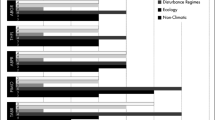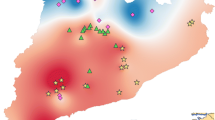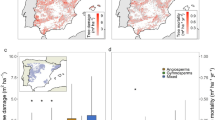Abstract
Bristlecone pine has been called the world’s oldest known living thing. The tree grows in mountainous terrain near timberline in three southwestern states. Because of the species’ longevity, sensitivity to climatic fluctuations, and unique growth form, it has attracted considerable attention from both scientists and recreationists. This paper discusses bristlecone pine in relation to its environment in east-central Nevada and sets forth criteria for recognizing trees that may be old or sensitive to climatic changes.
Similar content being viewed by others
Literature Cited
Bailey, D. K. 1970. Phytogeography and taxonomy ofPinus subsectionBalfourianae. Ann. Mo. Bot. Gard.57: 210–249.
Beasley, R. S. 1972. Bristlecone pine (Pinus longaeva) in relationship to environmental factors and soil properties in east-central Nevada. Ph.D. Dissertation, Univ. of Arizona, Tucson. 151 pp.
Currey, D. R. 1965. An ancient bristlecone pine stand in eastern Nevada. Ecology46: 564–566.
Ferguson, C. W. 1970. Bristlecone pine chronology and calibration of the radiocarbon time scale.In: Tree-Ring Analysis with Special Reference to Northwest America, pp. 88–91. J. H. G. Smith and J. Worrall (Eds.). The University of British Columbia, Faculty of Forestry Bull. No. 7.
Fritts, H. C. 1966. Growth-rings of trees: their correlation with climate. Science154: 973–979.
Fritts, H. C. 1969. Bristlecone pine in the White Mountains of California. University of Arizona Press, Tucson. 44 pp.
LaMarche, V. C. 1968. Rates of slope degradation as determined from botanical evidence, White Mountains, California. U.S. Geol. Surv. Prof. Pap. 352-I, pp. 341–377.
Schulman, E. 1958. Bristlecone pine, oldest known living thing. Natl. Geogr. Mag.113(3): 354–372.
Schulman, E. and C. W. Ferguson 1956. Millennia-old pine trees sampled in 1954 and 1955.In: Dendroclimatic Changes in Semiarid America, by E. Schulman, pp. 136–138. The University of Arizona Press, Tucson.
Stokes, M. A. and T. L. Smiley 1968. An introduction to tree-ring dating. The University of Chicago Press, Chicago. 73 pp.
Stuiver, M. and H. E. Suess 1966. On the relationship between radiocarbon dates and sample ages. Radiocarbon8: 534–539.
Suess, H. E. 1967. Bristlecone pine calibration of the radiocarbon time scale from 4100 B.C. to 1500 B.C.In: Radioactive dating and methods of low level counting, pp. 143–151. International Atomic Energy Agency, Vienna.
Wright, R. D. and H. A. Mooney 1965. Substrate oriented distribution of bristlecone pine in the White Mountains of California. Am. Midi. Nat.73(2): 257–284.
Additional information
Associate Hydrologist stationed at Forest Hydrology Laboratory, which the Southern Forest Experiment Station, USDA Forest Service, maintains at Oxford, Miss., in cooperation with the University of Mississippi, and Professor Department of Watershed Management, University of Arizona, Tucson, respectively. A Contribution of the Arizona Agricultural Experiment Station, Journal article No. 2123, and the USDA Forest Service, Region Four.
Rights and permissions
About this article
Cite this article
Beasley, R.S., Klemmedson, J.O. Recognizing site adversity and drought-sensitive trees in stands of bristlecone pine (Pinus longaeva). Econ Bot 27, 141–146 (1973). https://doi.org/10.1007/BF02862228
Issue Date:
DOI: https://doi.org/10.1007/BF02862228




